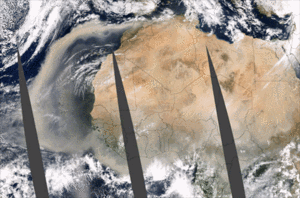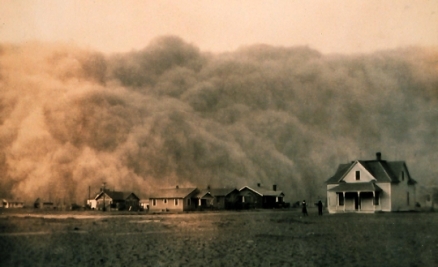Global dust budget
Contents
- 1 Introduction The global dust budget refers to an accounting of the emission, atmospheric loading, and deposition of the mineral dust aerosol (Global dust budget) on a global scale. The topic covers the location and strength of sources, transport paths, atmospheric distribution, and deposition of mineral dust aerosol. A satellite image of the Saharan dust traveling over the Atlantic, 11 March 2004. The image was taken by the Moderate Resolution Imaging Spectroradiometer (MODIS). (Source: NASA Earth Observatory & Natural Hazards)
- 2 Emission
- 3 Deposition
- 4 Atmospheric loading
- 5 Human influence on dust emission
- 6 Variability of global dust budget and climatic conditions
- 7 Further Reading
Introduction The global dust budget refers to an accounting of the emission, atmospheric loading, and deposition of the mineral dust aerosol (Global dust budget) on a global scale. The topic covers the location and strength of sources, transport paths, atmospheric distribution, and deposition of mineral dust aerosol.  A satellite image of the Saharan dust traveling over the Atlantic, 11 March 2004. The image was taken by the Moderate Resolution Imaging Spectroradiometer (MODIS). (Source: NASA Earth Observatory & Natural Hazards)
A satellite image of the Saharan dust traveling over the Atlantic, 11 March 2004. The image was taken by the Moderate Resolution Imaging Spectroradiometer (MODIS). (Source: NASA Earth Observatory & Natural Hazards)
 A satellite image of the Saharan dust traveling over the Atlantic, 11 March 2004. The image was taken by the Moderate Resolution Imaging Spectroradiometer (MODIS). (Source: NASA Earth Observatory & Natural Hazards)
A satellite image of the Saharan dust traveling over the Atlantic, 11 March 2004. The image was taken by the Moderate Resolution Imaging Spectroradiometer (MODIS). (Source: NASA Earth Observatory & Natural Hazards) Soil particles are entrained into the air by wind erosion caused by strong winds over bare ground. While large sand particles quickly fall onto the ground, smaller particles (less than about 10 micrometers [μm]) stay suspended in the air as mineral (or soil) dust aerosol. Billions of tons of mineral dust aerosols are released each year from arid and semi-arid regions to the atmosphere. Mineral dust aerosol can be transported long distances, and can influence the air quality far beyond the source region. For example, North African (Saharan) dust is often transported over the Atlantic Ocean, reaching the North or South American continents, and dust from East Asian deserts travels over the Pacific Ocean and occasionally influences air quality in North America. Since these large-scale dust events have been captured by satellite imagery, the issue of mineral dust has been recognized as a global-scale problem.
The global dust budget has been recognized as an important research topic related to the atmospheric environment and climate. Mineral dust aerosol can cause air quality hazards such as visibility impairment and respiratory problems, which can pose risks to human health and society. Mineral dust aerosols also play an important role in the Earth's climate in several ways, including exerting a significant direct and indirect influence on the atmospheric radiation balance. They do so directly through scattering and absorbing shortwave and longwave radiation, and indirectly by acting as cloud condensation nuclei or ice nuclei and modifying the optical properties of clouds. In addition, dust aerosol can serve as a reaction surface for reactive gases, thus affecting atmospheric photochemistry. When these aerosols falls onto the ocean, the iron content in dust acts as a nutrient for marine phytoplankton and can thus enhance photosynthesis, in turn influencing the global carbon cycle.
Quantification of the global dust budget is still a challenging issue because direct observation of dust emission and deposition over a wide area is difficult. Because of the difficulty of estimating the dust budget at the global scale, most of the currently reported dust budget values are based on numerical simulations using global dust transport models.
Emission
Locations of dust sources
Dust emission is associated with many environmental parameters. Generally, dust storms are caused by strong, gusty winds associated with the synoptic-scale disturbances or meso- or micro-scale thermal convective activities. Dust emission is inhibited by surface-covering elements such as vegetation, snow cover, and giant rocks, and soil-binding elements including high soil moisture and salt content. With these conditions, active dust-producing areas are confined to bare ground or sparsely vegetated ground with annual rainfall under 200–250 millimeters (mm), and to regions with strong winds.
Recent progress in satellite retrievals using the Infrared Difference Dust Index (IDDI) and Absorbing Aerosol Index has helped reveal that the largest dust sources are located in the Northern Hemisphere, mainly in a broad “dust belt”, which extends from North Africa, over the Middle East and Central and South Asia, and to China. Satellite imagery has identified climatologically active dust sources or so-called “hot spots,” which are associated with topographic depressions that are lower in elevation than their surroundings. These hot spots coincide with regions where alluvial sediments have accumulated, such as dry lake beds and ephemeral channels, and tend to have high silt content. The Bodélé Depression in central Chad, the Tarim Basin (Taklimakan Desert) in China, and Lake Eyre in Australia are typical hot-spot regions.
Estimates of global dust emission
Global dust emission strength is estimated using data on dust loading in the atmosphere, surface material characteristics, marine sediments, and numerical dust transport models. Recent studies estimate that global dust-emission rates falls within a range from less than 1000 to 3000 teragrams (Tg) yr–1, and about 80% of the dust is from the Northern Hemisphere. Estimates show a wide range of values, reflecting differences in modeling procedures, model resolution, the considered time scale, and specification of the source areas. The world's largest source of dust is the Sahara Desert, and the estimated range of dust emission from the Sahara Desert is from 160 to 760 Tg yr–1, ranging from one-third to over half of the total global dust emission. See also the entry on the air pollution emissions for global dust emission estimate by Intergovernmental Panel on Climate Change (2001).
Deposition
Mineral dust aerosol is removed from the atmosphere by direct contact with the surface without precipitation (dry deposition), or through scavenging by cloud droplet and precipitation (wet deposition). Generally, larger dust particles (about > 1 μm) are removed by dry deposition because of their large mass and gravitational settling velocity, and smaller particles are primarily removed by wet deposition. However, the numerically estimated ratio of dry and wet deposition fluxes is highly model-dependent, as a result of different parameterizations of the deposition processes, assumed hygroscopicity, and particle size distribution.
Atmospheric loading
Mineral dust particles are estimated to be the most common aerosol by mass. Current estimates of the atmospheric dust loading range from less than 10 Tg to 35 Tg, an uncertainty factor of about 3–4.
Human influence on dust emission
While dust storms are natural events, human activities such as inappropriate agricultural practices, overgrazing, and deforestation cause soil degradation and desertification, thus strongly influencing the availability of dust by surface disturbances. It has been pointed out that the atmospheric dust loading has been increased as a result of such activities. The contribution of anthropogenically disturbed [[soil]s] to global dust emissions has been estimated to be as high as 30% to 50%. However, recent research suggests that agricultural areas contribute less than 10% to the dust load. Thus, natural causes are currently considered to be the primary source of dust emission on a global scale.
Variability of global dust budget and climatic conditions
Climatic conditions strongly influence the global dust budget.
Climate indices and dust
It has been suggested that the variability of dust is related to some climate indices, although the relationships are not fully understood. Among the relationships, the North African dust concentrations in winter are thought to be related to the North Atlantic Oscillation (NAO) and El Niño and Southern Oscillation (ENSO). In the context of the long-term variability of Asian dust, correlation analyses of climate indices and dust emission simulations suggest that Asian dust emissions strongly correlate with climate indices related to the divergence of cold air from the polar region to the mid-latitudes in March. In addition, they correlate strongly with climate indices related to the south-north pressure gradient over the Gobi Desert in April.
Global dust budget in the glacial periods
During glacial periods, increased dust concentrations relative to the current climate are recorded in marine, terrestrial, and ice-core records. In the Last Glacial Maximum (approximately 20,000 years ago), mineral dust deposition rates were approximately 2–5 times greater in the tropics and mid-latitudes than they are at present, and up to 20 times greater in polar regions. Primary sources of the glacial dust deposition are considered to be the Asian deserts for the Arctic and Patagonia for Antarctica. Possible reasons for the dust increase during the glacial ages are:
- increased wind speed produced more dust emission and increased transport distance;
- decreased vegetation cover and increased of continental shelf area enhanced the bare ground; and
- decreased precipitation reduced the rate of dust deposition.
Effect of global warming
The potential for future changes in the dust budget with anticipated global warming attracts considerable interest. In contrast to the response in the glacial periods, there is a possibility that global dust concentration will decrease with global warming. Climate models coupled with vegetation models suggest major vegetation changes, including accelerated desertification, which can lead to an increase in possible dust sources. Estimates of future atmospheric dust using possible scenarios suggest that dust emissions may increase or decrease with future climate change, depending on the scenario or the numerical model.
Further Reading
- Goudie, A. S. and N. J. Middleton, 2006. Desert Dust in the Global System. Springer. .
- Hara, Y. et al., 2006. Long-term variation of Asian dust and related climate factors. Atmospheric Environment, 40:6730–6740.
- Moulin, C., et al., 1997: Control of atmospheric export of dust from North Africa by the North Atlantic Oscillation. Nature, 387:691–694.
- Penner, J. E., et al., 2001. Climate Change 2001: The Scientific Basis, Contribution of Working Group I to the Third Assessment Report of the Intergovernmental Panel on Climate Change. Cambridge University Press, New York, chapter 5, 289–348. .
- Prospero, J. M., et al., 2002. Environmental characterization of global sources of atmospheric soil dust identified with the Nimbus 7 total ozone mapping spectrometer (TOMS) absorbing aerosol product. Reviews of Geophysics, 40(1):1002, doi:10.1029/2000RG000095.
- Pye, K., 1987. Aeolian Dust and Dust Deposits. Academic Press. .
- Shao, Y., 2000. Physics and Modelling of Wind Erosion. Vol. 23 of Atmospheric and Oceanographic Sciences Library. Kluwer Academic Press. .
- Sokolik, I. N. and O. B. Toon, 1999. Incorporation of mineralogical composition into models of the radiative properties of mineral aerosol from UV to IR wavelengths. Journal of Geophysical Research, 104:9423–9444.
- Tegen, I. and I. Fung, 1995. Contribution to the atmospheric mineral aerosol load from land surface modification. Journal of Geophysical Research, 100:18707–18726.
- Tegen, I., et al., 2004. Relative importance of climate and land use in determining present and future global soil dust emission. Geophysical Research Letters, 31, L05105, doi:10.1029/2003GL019216.
- Zender, C. S., et al., 2004. Quantifying mineral dust mass budgets: Terminology, constraints, and current estimates. Eos, 85:509–512.
